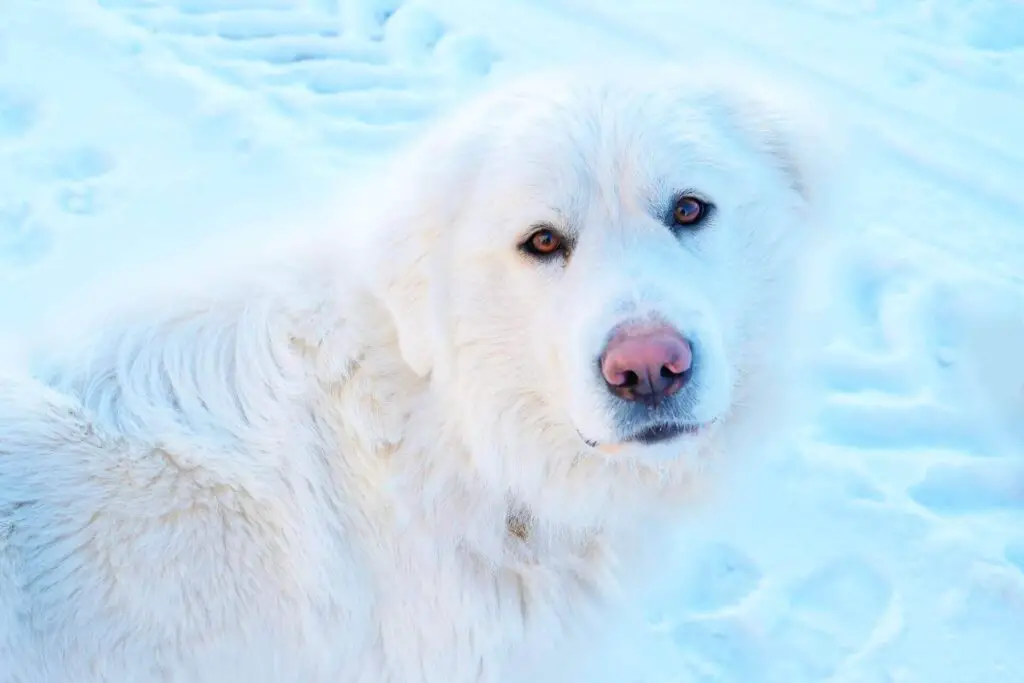Dogs with pink noses are not as cute as those with a normal nose. But there’s nothing we can do about the physical make-up of dogs’ noses since it’s something that’s unique to each dog. There are also cases when dogs with pink noses are carriers of certain diseases and infections.
Although they have this trait, there’s still no guarantee that dogs with pink nose are not carriers of the mentioned diseases. However, if your dog has one, you should know what to look for so that you can treat it quickly and prevent it from getting worse.

What dogs have pink noses?
Most people are surprised at what breeds of dogs have pink noses. Some dogs with pink noses are Cocker spaniel, Australian shepherd, Nova scotia, Siberian Husky, English Springer, and Labrador retriever.
While all of these dogs can be beautiful, some have more pink pigmentation on their nose than others.
A Labrador Retriever is one example of a dog breeds with liver noses. These dogs are very cute and easy to groom. They are good, hard-working dogs that make great pets.
They are also fairly quiet and do not tend to bark much. They are not the best-mixed breed dogs but are often as good or better as the other types.
Why do some dogs have pink noses?
Many people are surprised to see that some dogs do have a pink nose or liver nose. This is because the pigment in the skin can be very light and even white in some breeds.
These dogs might have a genetic predisposition to having a light-colored nose, but other factors could cause it. The nose may be colored because of a disease that has set off the pigmentation, or it might just be because of a chemical reaction in the body.
Check your dog for sores on their nose. If there is an abrasion or scratch on your dog’s nose, its nose will turn pink due to the skin’s healing process. But after some time, it will return to its original skin color.
Other factors, such as when the dog is older, you can see the pink spot on dog nose and widen. The older the dog, the weaker the melanin enzyme tyrosinase production, which is needed to maintain a dog’s skin color.
Why do dogs have pink noses?
Not all dogs can get categorized as dogs with pink noses. Some of them have a pink nose from birth, but some turn pink because of something for some other types.
Some are due to cold air, exposure to wounds, or certain diseases such as reduced pigment production or irritation. Or you see puppies born with pink noses but darkens after they get older.
What is Dudley nose?
Dudley nose dog is a condition in which a dog breeds a black nose but gradually changes to a pink nose due to nasal depigmentation.
Their noses are a solid black nose from the initial condition, and gradually their noses will fade to a pale brown color. If depigmentation continues, it will turn Dudley nose to pinkish white.
It’s worth noting that while the condition can be distressing for your dog, it’s not dangerous.
Your dog shouldn’t be given any medication unless your vet recommends it, and if your dog has been affected by this condition before, he may well get a reaction to the medication anyway.
Snow Nose Dogs
Winter or snow nose is when dog nose colors change due to loss of pigment due to winter weather.
There is no definitive answer about why the color of the nose turns pink during winter, and the characteristics are the dog nose pink spot. Some parts of their nose are pink.
When the weather is warm again, and the sunlight is getting longer, the color of your dog’s nose will return to its original color.
This is different from dog breeds with liver noses because, during winter or summer, their noses remain pink because of their genetics or lack of pigmentation from their breed.
Does snow nose go away?
Dogs with pink noses are not considered snow noses, as they can go away when the weather warms up again. There is no need for special treatment to restore the color of the nose from the snow nose because it will return to normal over time.
Snow nose will not change the texture and moisture of the dog’s nose. It only changes the color of the nose, typically only in the middle of the nose.
Butterfly Nose Dog Breeds
Dog butterfly nose is one of a kind of dogs with pink noses. A randomly located bright pink patches on its nose leather belongs to the type of butterfly nose dog.
There are several types of patches, including tiny pink spots all over the nose or patches covering any part of the nose. Several types of dogs that have butterfly noses are Boxer, Bull Terrier, and Dogo Argentino.
Puppies Born With Pink Noses
Puppies can be born with a pink nose or light pink, which will darken as they get older. The time for changing color varies, from 8-16 weeks or up to a year.
But it can be seen from how your puppies were born, depends on their genetics. For example, a Goldendoodle with pink nose will still have a pink nose for their whole lives.
Dogs with pink noses genetically will remain a pink noses throughout their life, because the level of their pigmentation is different from birth.
Even though you are born with a pink nose, this color will change over the years when affected by sun exposure.
Puppy Nose Pigmentation Colors
Puppy nose pigmentation depends on their breed. When your puppy is a white dog with pink nose, such as a dalmatian, white german shepherd, or a poodle, it is not in terms of pigmentation, but genetics is that way.
But if your puppy’s breed belongs to a black nose, it will gradually darken over time.
What does it mean when a dog has a pink nose?
A pink nose dog is a sign of an illness, not necessarily a disease. The color of the nose can be either white or bluish-green. Dogs with light-colored noses are less likely to have cancer. There are different breeds of dog, and each breed has a slightly different coloring of the nose.
A veterinarian can give you the answers you’re looking for regarding dogs with pink noses. A benign tumor in the nose called malignant melanoma is the most common cause of a pink nose in dogs.
The color changes as the dog ages. However, this change isn’t always correct. If your older dog’s nose looks pink but turns red when he gets older, there is still a chance that the tumor is benign.
If the tumor is malignant, the color of the nose may change dramatically. Your dog’s overall appearance may change, with drooping eyes and a wrinkled face.
This happens because the lymph nodes under the skin start shrinking, and the immune system starts to attack the cancerous cells.
Why did my dog’s nose turn from black to pink?
Several factors can cause dogs with pink noses, and it starts with black noses. One of them is that as your dog gets older, their nose fewer pigments and slowly turns pink.
There are also several breeds of dogs, including the Dudley nose with liver color. The reasons still unknown, but the result is because of nasal depigmentation. Some dogs were able to return to their origin nose colors.

Dogs With Pink Noses Causes
Several things cause pink noses, such as snow noses, scars, irritation, or allergic reaction. There are also types of dogs with pink noses, Dudley noses, dogs with red noses, or butterfly noses.
You have to distinguish several types of dogs that have pink noses so that you don’t get confused when your dog has a pink nose.
Let’s take a look at the table of breeds of dogs with pink noses.
| Liver Nose Dog breeds | Dudley Nose Dog breeds | Butterfly Nose Dog breeds |
| Field Spaniel | White German Shepherd | Dogo Argentino |
| English Springer | Doberman Pinscher | Boxer |
| Dalmatian | Poodle | Bull Terrier |
| Siberian Husky | Irish Setter | Dogs associated with merles |
| Nova Scotia | Samoyed |
Do Dogs Noses Stay Pink?
Your dog’s nose will stay pink if it’s genetic red or liver dogs. But if your dog is not included in the genetic, you need to look at some of the possibilities. For example, puppy nose color change. This occurs in puppies during infancy, in most cases the first eight weeks after they are born.
Their nose color starts from pink and will change to the color of their coat as they age. Their noses won’t stay pink, but they will darken more over time. You can confirm your dog to the vet when your dog breed does not belong to liver dogs or dogs with pink noses.
Dogs With Pink Nose Breeds
Some dogs with pink noses, but not all are equally colored. There are two breeds of dogs that have this trait: the Standard Poodle and the Toy Poodle.
The Toy Poodle is a much more common breed than the Standard Poodle because they were imported into the United States from Germany in the 1970’s.
A Toy Poodle is a dog breeds with pink noses, although they can be found in colors like fawn, blue, black, and white. The American Kennel Club classifies these dogs as a toy or shows dogs.
Dogs with pink noses are very cute, and because of their distinct look, they tend to draw people in. It doesn’t matter what kind of dog you have because almost any color will do.
Dudley Labradors – Labs Pink Noses
Many people know of the Labradors, but few know that these dogs are one of the world’s rarest breeds. A Dudley Labrador is a type of Labrador born without pigment in their eye rims, feet, and nose.
All Labradors are dogs with pink noses, and their eyes are teal or blue. From the pink nose lab, Labradors’ noses are brown or black in the first few weeks of life.
It is necessary to distinguish from albinos, as Dudley Labradors have very little melanin, and the lack of pigmentation does not affect some parts of their body.
Due to the lack of pigmentation, Dudley’s nose had to be protected from sunburn. Therefore it needs special measures to protect their noses.
Do pink noses on puppies turn black?
It depends on their breeds. You might wonder what causes a nose to turn black on puppies. The truth is that puppies cannot control the pigment changes that occur as they get older.
These changes can affect both the color of their fur and their skin. But if your dog is included in dogs with pink noses, then the color of the nose will remain pink for the rest of their life.
Is it bad if my dog’s nose is turning pink?
If your dog is over six years old and has pink sides like liver nose dogs or has pink spots, there is nothing to worry about.
But if their nose is cracked, dry, or scaly, you should ask your vet, especially if your dog starts doing strange things to their nose like licking it or scratching it now and then. There is a possibility of irritation of their nose or other diseases.
There are many illnesses out there, and they can cause the pet to develop a bad odor around its nose. In some cases, the odor can be a clear sign of a more serious issue, like cancer or neurological problems.
If this is something you’re concerned about, it is good to talk to a vet and see what she recommends.
Do dogs with pink noses need sunscreen?
Since dogs are warm-blooded creatures, they need the sun’s ultraviolet (UV) rays as much as humans do. As humans, we derive satisfaction from the sun’s healthy rays, but dogs need it just as much.
However, dogs with pink noses like to go out into the sun a lot, so it may be wise to purchase a specially formulated sunscreen for dog pink nose to keep them protected.
Are all puppies born with pink noses?
Many people ask this question when they see dogs with pink noses. There is no guarantee that a puppy is born with a pink nose, but it is more common than you may think.
Puppies do not always come out looking their best, and although the breeder is responsible for screening, breeders have no control over whether or not the puppies have pink, crooked, or misshapen noses.
If you see that your puppy has a pink nose and blue eyes, it could be that your puppy is an albino dog. The special characteristics of albinos are dogs with pink noses and blue eyes.
You can confirm whether your puppy is albino to your vet because albino dogs have a higher risk for health issues.
Why is my lab’s nose turning pink?
When your yellow Labrador’s nose turns pink, but when you are young, you have a black nose, it is because of the depigmentation process, and this is a common thing.
There is nothing to worry about. Pigment from yellow Labrador’s nose produces an enzyme called tyrosinase that makes melanin. But tyrosinase will decrease as your Labrador ages. Labrador is often called a liver nose dog.
Do metal bowls turn dogs noses pink?
Stainless steel or metal bowls do not affect the nose color of your dog. It could be a rubber food bowl or plastic that can change the color of your dog’s nose to a pinkish color.
Also, consider the health benefits of a stainless steel bowl, as they are usually dishwasher safe and non-allergenic. Whether you choose plastic or stainless steel bowls, there is a better choice out there for your dog.
Do dogs noses change color as they age?
You need to know first what kind of dogs have pink noses and others with black noses. Each dog is different, and each breed of dog is slightly different than the next.
You might notice as you are looking at your dog’s nose because it has a slight curl at the end of it. If you have a light-colored dog, that curl will be darker than that of a dark-colored dog.
There are many reasons that dogs’ noses can change in color with age. Some of those reasons are due to genetic conditions, some are due to common colds and allergies, and some are due to the type of dog you have.
For example, the yellow Labrador’s nose will change color from black to pink. And dogs with reduced pigmentation will change their nose color from black to pink.

How To Treat Dogs With Pink Noses?
When you have several different breeds of dog, make sure which dogs have pink noses. To treat dogs with pink noses, you don’t need special handling if they are snow nose types because their noses change color seasonally.
But if your dog has a pink nose due to pigmentation problems, then there are special things you should take care of your dog.
Make sure you ask your vet about your dog’s pink nose’s condition and tell your vet the initial color of your dog’s nose.
Your vet will provide advice such as protecting your dog’s nose with sunscreen or giving special treatment if your dog experiences irritation on their nose.

Welcome to Learn About Pet. My name is Rajkumar Ravichandran and I love all pets, travel, and amazing food. I write about my passion and personal experience caring for multiple pets in this blog! ❤️
Post Disclaimer
DISCLAIMER: THIS BLOG OR WEBSITE, "Learn About Pet", DOES NOT PROVIDE YOU WITH MEDICAL ADVICE AND IS NOT A SUBSTITUTE FOR MEDICAL ADVICE. ALWAYS GET IN TOUCH WITH YOUR PERSONAL VETERINARIAN AND USE INFORMATION HERE AS GENERAL ADVICE.
The information, including but not limited to, text, graphics, images and other material contained on this website are for informational purposes only. No material on this site is intended to be a substitute for professional veterinary advice, food recommendation, diagnosis, or treatment. Always seek the advice of your veterinarian or other qualified health care provider with any questions you may have regarding a medical condition or for pet food related questions.







